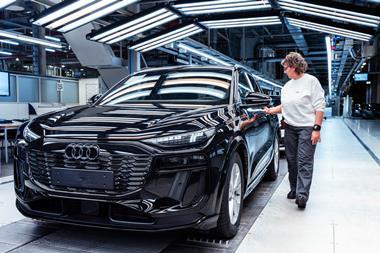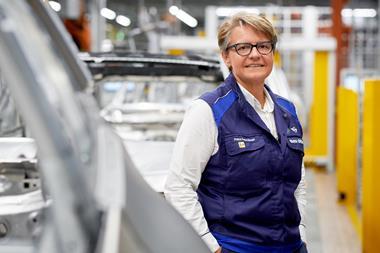Colours can have a profound influence on people and subtly influence their car buying decisions; two young designers talk about their view of the changing demographics of colour
Turbulence, crisis, recession. Today's events of the global markets have an impact on trends. “It’s true that uncertainty and tension are impacting current trends. But when it comes to the world of colours, we are not observing a doomsday mentality,” said Eva Höfli and Mark Gutjahr, colour designers at BASF Coatings AG. Quite the opposite in fact. Colours actually reinforce the trend by taking on, processing and reflecting topics ranging from harmony to confusion and even the crisis itself. Thus, colours will continue to serve as a factor in the emotions accompanying the decision to buy a car.
While in the past the colour spectrum focused on the spectacular, it is now featuring very individual, even personal colours. “What will the future bring?” is the question of the hour, reflecting a shift to a level headed concentration on one’s own capacity rather than the high-strung cutthroat attitude of the past. “In an impressive manner, the global financial crisis has demonstrated the fragility of the material fortune we cling to,” said Gutjahr. In line with this, the automotive colour trends of tomorrow are reflecting the realization that there’s more to life than material wealth. Gutjahr and Höfli are observing three major developments:
Gray-rosé: Light, pastel areas on a cool, metallic basic colour
Apricot: Very delicate, light colours with a high share of white and grey
Brown to bronze: Deep, warm browns from dark honey to chocolate and bronzes
Green: Gray-greens or silvery nuances; very warm and with a coloured flip effect
Dark green: Rich colour with golden highlight and dark flip effect
Blue: Deep, cool areas with inclusion of green and turquoise (no red tinge)
The new eco-drivers: Guardians of the earth
Environmental concerns have had wide repercussions and are gaining in significance. Former “eco-activists” have become the guardians of the earth with a powerful impact on trends. For them, ecology, individuality and awareness of luxury are inseparable. They have broadened their thematic and emotional horizons, which in turn impacts the tenor of the colour climate. “In this ‘new ecology,’ we are observing sensual pastels ranging from a greyed apricot to a yellowish beige,” Höfli said. Green, the colour logo of the ecology movement, is developing more toward warmer, more discreet colour ranges and in so doing, reflects a more conscientious and subtly expressed awareness of ecological concerns. Warm browns are also part of the repertoire. “The notions of reductionism and ‘going without’ used to be associated with ‘green ideology.’ That has changed today. These days, an ecological mindset can also be luxurious and elegant,” said Gutjahr, describing society's change in attitude.
In addition to this abstract natural approach to life, the colour spectrum of intelligent ecology is also showing its emotional sides. Powerful blues and dark, warm greens are being used with a great deal of sensitivity and intensity. Chromatic highlights and a shift in colours toward black charge these strong natural colours emotionally and infuse them with drama. In this area, copper and bronze tints are important sources of inspiration.
Yellow: Powerful colour spaces with a tendency toward green and a lot of special effects
Red: Intensive colours with pink flip effect
Blue: Icy blue areas with lots of effect and little flip effect
Violet: Dark basic colour with very coarse effect
Time for something new, or the joy of experimenting
Of course, the world of automotive colour trends will continue to be a laboratory for boundless experimenting. The approach is self-confident, sophisticated and at the same time playful, guided by a lively landscape of art and culture. “We call the results Bold Colours,” Gutjahr said. They are marked by strong, bold colours such as toxic yellows and red and pink combinations, which grab one's gaze with an unusual chromatic colour shift. The extreme sparkle effects in icy blue and dark violet attract special attention. “In this area, you can clearly recognize the joy of experimenting,” Gutjahr explained.
“In the world of colour, the dwindling confidence in a complex world not only triggers the flight response, but also brings out courage and the inspiration to set out on an unknown course.”
Black: Deep, extremely dark colours with subtle special effects/sparkles
Black: Colour travel; e.g. from red to green
Black: Dark basic colour with colour highlights from red to beyond violet
White: Warm, fractured colour areas with elements of beige
Anthracite: Dark and super fine with minimal red or green special effects
Turning old into new, or: Beyond silver
New raw materials are being sought that can be used to construct the colour world of tomorrow. Indications of new demands for science and technology are also in the air for futuristic metals. Instead of technical bells and whistles, sensual moments such as haptics are top priority. The goal is a new approach to the world. A soft and almost wax-like surface look and bright, fractured white areas are indications of a growing interest in model-like and shape-able things. “We have moved beyond the classic metal look,” Höfli said. Important elements of special effect design for this area are extremely bright sparkles. Dark and tinted silver and black with strong colour travel and high-effect deep black are other prominent representatives of this trend world.
































